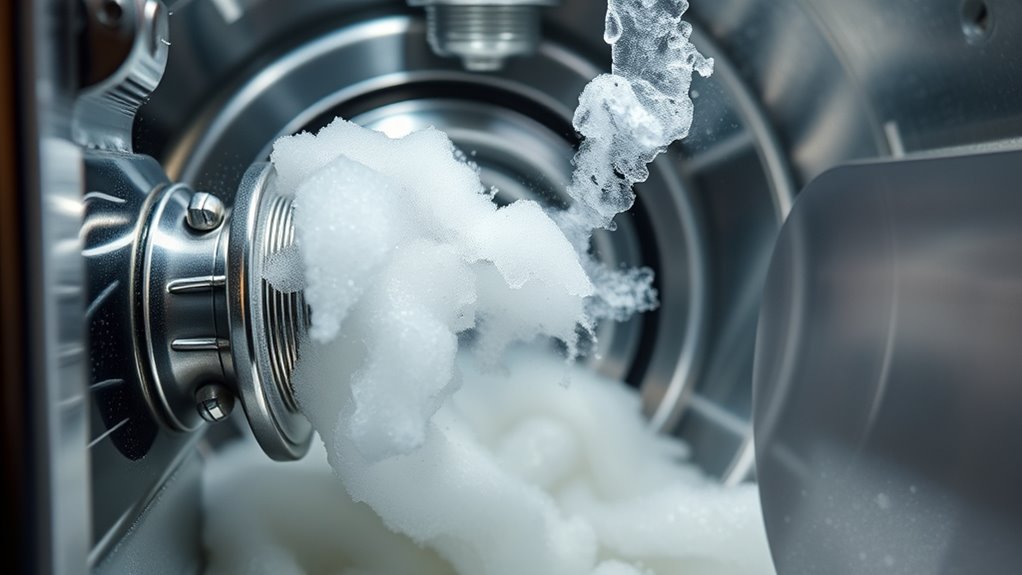The science behind ice cream machines combines thermodynamics and advanced compressor technology to turn liquid ingredients into smooth, frozen treats. The process rapidly cools the mixture by precisely controlling temperature and heat transfer, preventing large ice crystals from forming. The compressor compresses refrigerant gas, which releases heat and cools the mixture through evaporation. If you keep exploring, you’ll uncover how these cooling cycles create the perfect texture and consistency every time.
Key Takeaways
- Ice cream machines use rapid cooling and precise temperature control to prevent large ice crystals, ensuring a smooth texture.
- The compressor cycle compresses, condenses, and evaporates refrigerant to transfer heat and maintain a cold environment.
- Thermodynamic principles govern the cooling cycle, involving compression, heat release, expansion, and evaporation for efficient freezing.
- Modern machines incorporate advanced controls and eco-friendly refrigerants to optimize energy efficiency and performance.
- Effective cooling systems, based on refrigeration science, are essential for consistent, high-quality ice cream production.

Ice cream machines might seem simple, but they rely on fascinating science to turn liquid ingredients into smooth, creamy treats. At the core of this transformation is the freezing mechanism, a clever system that rapidly cools the mixture while preventing ice crystals from forming large, unpleasant chunks. This process hinges on understanding how to control temperature precisely and efficiently. When you start your machine, the freezing mechanism kicks in, pulling heat away from the liquid mixture. It does this through a series of thermodynamic processes that involve the compressor technology, which is the powerhouse behind the refrigeration cycle.
Compressor technology works by compressing a refrigerant gas, causing it to heat up as pressure increases. This hot, high-pressure gas then flows through coils, where it releases heat to the environment and cools down into a liquid. As the refrigerant expands and evaporates inside the cooling chamber, it absorbs heat from the mixture, rapidly lowering its temperature. This cycle continues seamlessly, maintaining a steady cold environment that freezes the mixture evenly. The effectiveness of this process is vital because it determines how smooth and creamy your ice cream will turn out. If the compressor isn’t up to par or the freezing mechanism isn’t working properly, you risk ice crystals forming, which can lead to grainy textures rather than silky smoothness.
Compressor cycles regulate cooling, ensuring smooth, creamy ice cream by preventing ice crystal formation.
The key to a successful ice cream is maintaining a consistent, ultra-cold environment, and that’s where compressor technology truly shines. It allows the machine to cycle on and off as needed, keeping the mixture at just the right temperature without over-freezing. This precise control ensures the liquid ingredients are transformed into a dense, creamy consistency. Additionally, modern compressor systems often feature advanced controls to optimize cooling, reduce energy consumption, and prolong the lifespan of the machine. Without the compressor and its related freezing mechanism, turning liquid into ice cream would be impossible, as the mixture would either not freeze enough or freeze unevenly, ruining the texture.
Furthermore, the efficiency of cooling systems is crucial for energy savings and environmental impact, making modern compressor designs increasingly important. In essence, when you’re enjoying that perfectly smooth scoop, remember it’s the sophisticated dance between the freezing mechanism and compressor technology that makes it happen. These components work tirelessly behind the scenes, applying the laws of thermodynamics to deliver your favorite frozen dessert. Their seamless operation guarantees you get a consistent, delightful treat every time, demonstrating how science quietly powers even the simplest pleasures. Efficient cooling systems play a crucial role in ensuring the quality of your ice cream, highlighting the importance of reliable compressor technology in the process. Understanding how thermodynamic principles are applied in this context underscores the marvel of modern refrigeration engineering. Additionally, advancements in refrigerant materials have contributed to more efficient and environmentally friendly cooling cycles, further improving the performance of these machines.
Frequently Asked Questions
How Do Ice Cream Machines Prevent Ice Crystal Formation?
You might wonder how ice cream machines prevent ice crystal formation. They do this by constantly churning the mixture, which keeps the ice crystals small and smooth. Proper machine maintenance guarantees everything runs efficiently, preventing unwanted ice buildup. Additionally, flavor infusion is added during churning, maintaining consistency. This combination of motion and upkeep helps you get perfectly creamy ice cream every time, free from large ice crystals.
What Role Does Air Incorporation Play in Ice Cream Texture?
Air infusion plays a vital role in improving ice cream texture by adding tiny air bubbles during churning. This process creates a light, creamy feel and prevents the ice cream from becoming too dense or icy. As you enjoy your treat, you’re experiencing texture enhancement through proper air incorporation, which makes each spoonful smoother and more enjoyable. Without this step, ice cream would be harder and less appealing.
How Do Different Flavors Affect the Freezing Process?
Did you know that adding different flavors can alter the freezing process by up to 15%? When you infuse flavors into ice cream, you’re not just adding taste—you’re impacting ingredient stability and how quickly the mixture freezes. Flavor infusion affects the ice crystals’ formation, making some flavors freeze faster or slower. So, each unique flavor requires precise control to guarantee your ice cream maintains that smooth, creamy texture you love.
What Are the Energy Requirements of Commercial Ice Cream Machines?
You might wonder about the energy requirements of commercial ice cream machines. These machines typically have high power consumption due to their need for continuous freezing and mixing. To guarantee ideal operation, look for models with good energy efficiency, which reduce power consumption without compromising performance. Proper maintenance and choosing energy-efficient models help you save on electricity costs while keeping your ice cream consistently frozen and delicious.
How Do Variations in Temperature Impact Ice Cream Consistency?
Temperature fluctuations are like a rollercoaster ride for your ice cream’s consistency, causing it to become either too soft or too hard. You see, precise temperature control is crucial; it guarantees smooth, creamy texture by maintaining the ideal cold environment. When temperatures vary, it disrupts the process, making your ice cream less enjoyable. Stability in temperature is the key to consistent quality and perfect scoops every time.
Conclusion
Now that you know the science behind ice cream machines, you can appreciate how they churn out that perfect scoop. Did you know that the average commercial ice cream machine can freeze up to 50 gallons of ice cream per hour? Next time you enjoy your favorite flavor, remember the fascinating engineering and science working behind the scenes to create that smooth, creamy delight you love. It’s a true blend of technology and culinary art!









